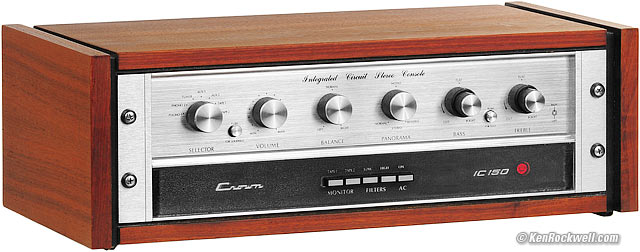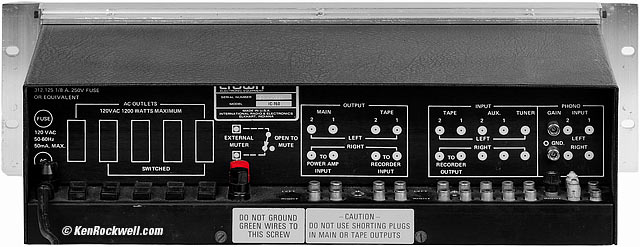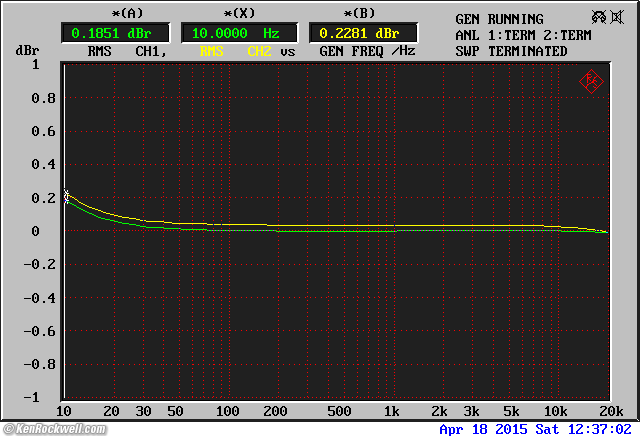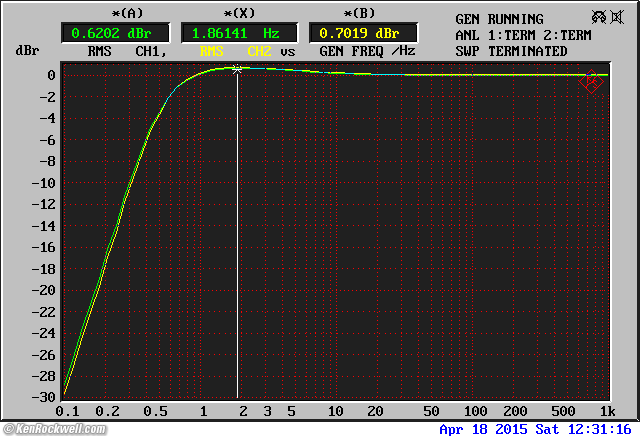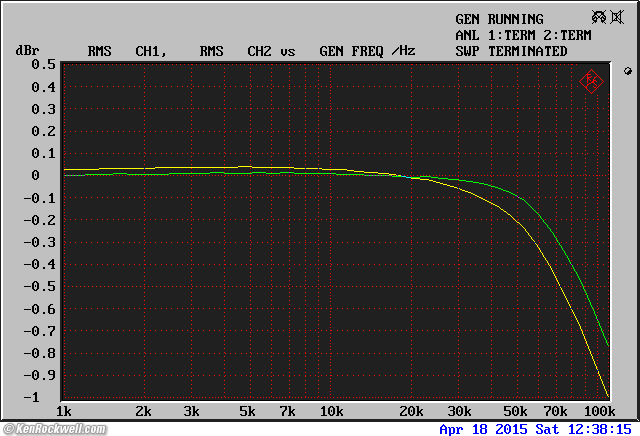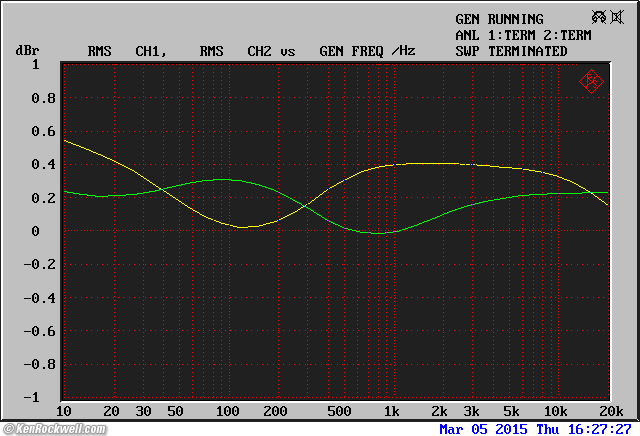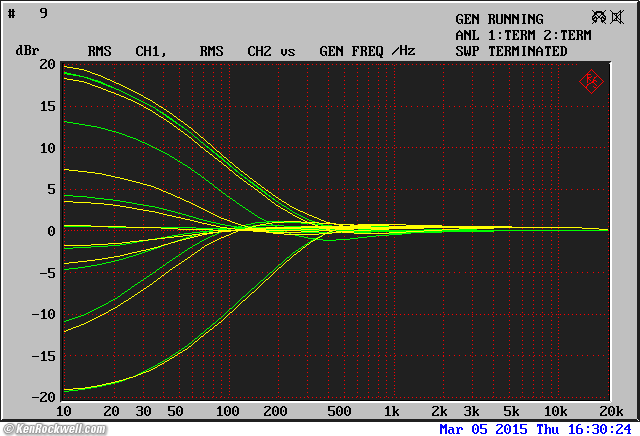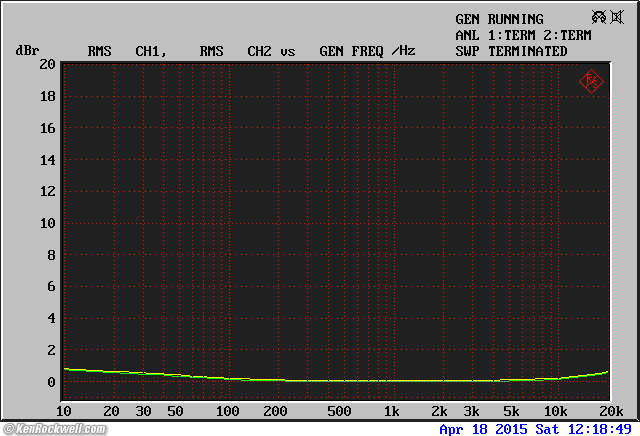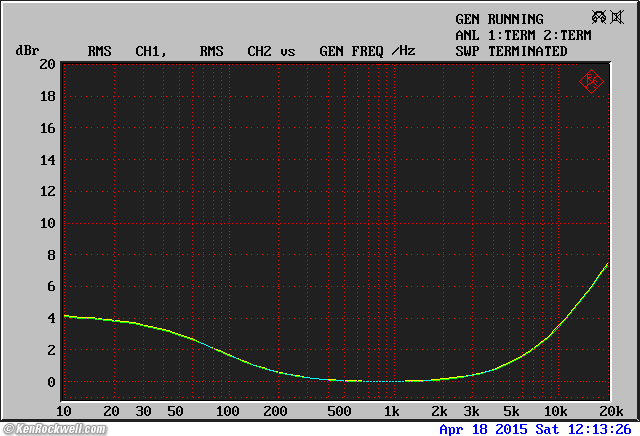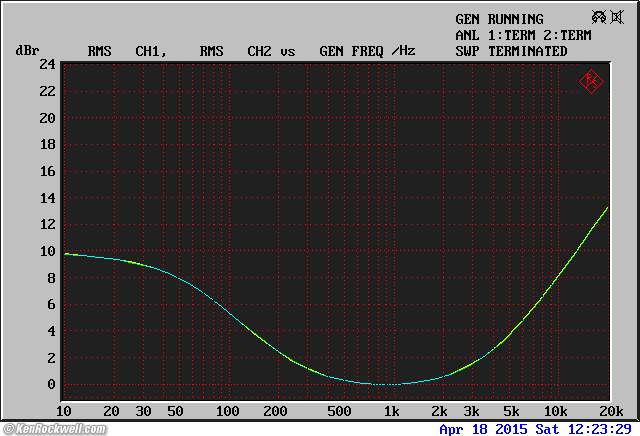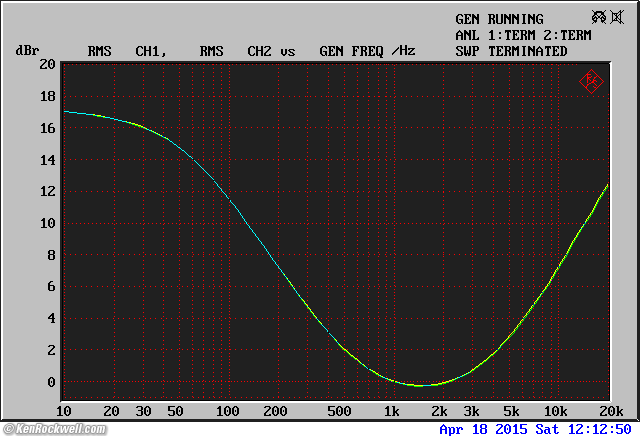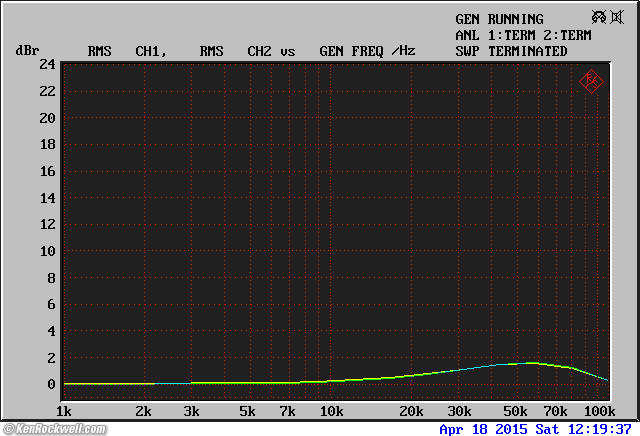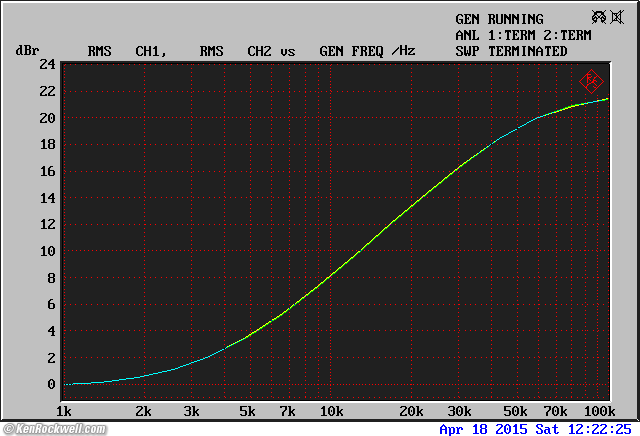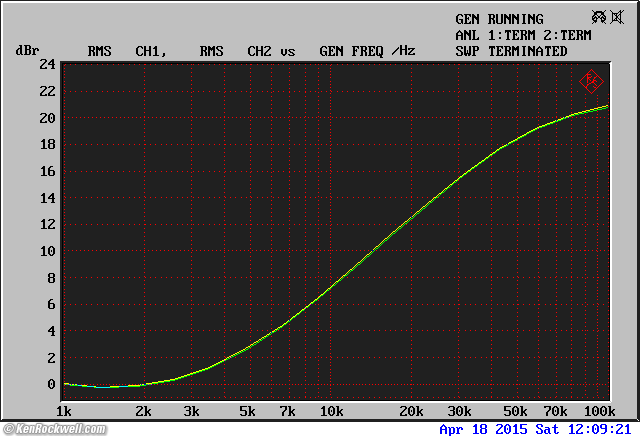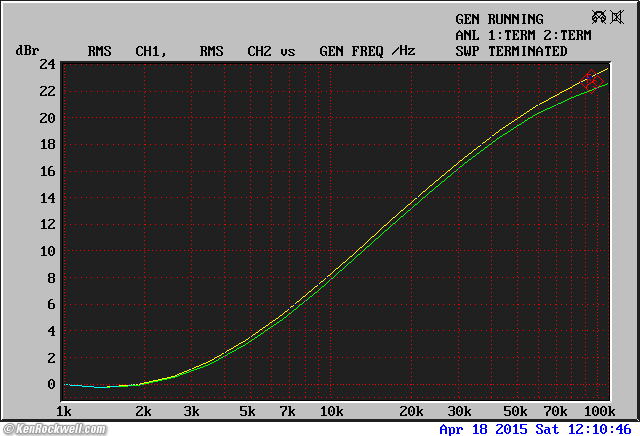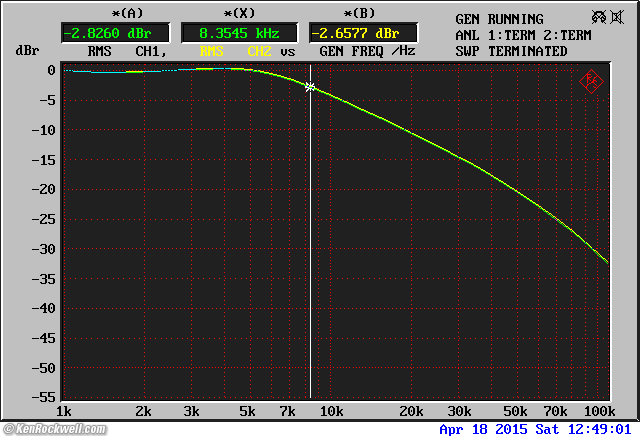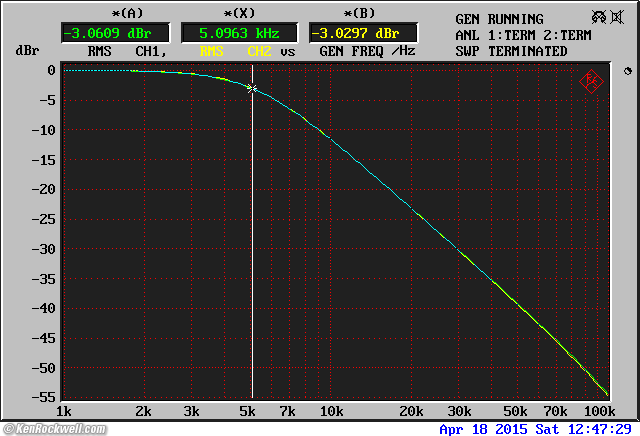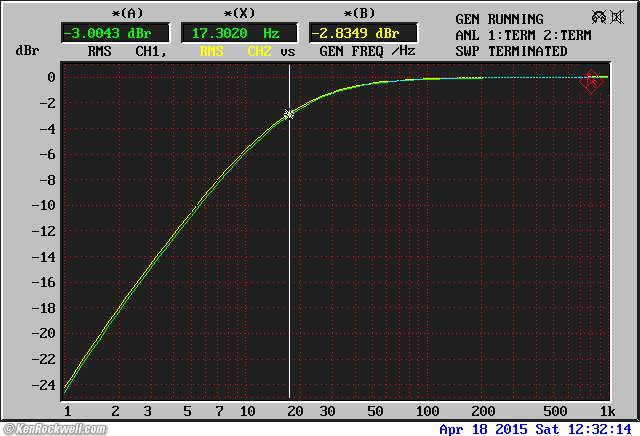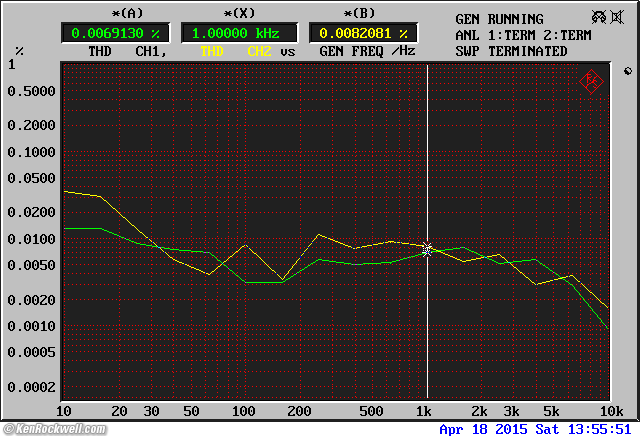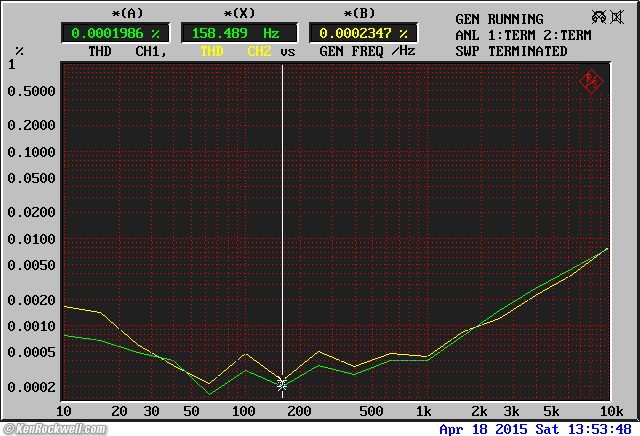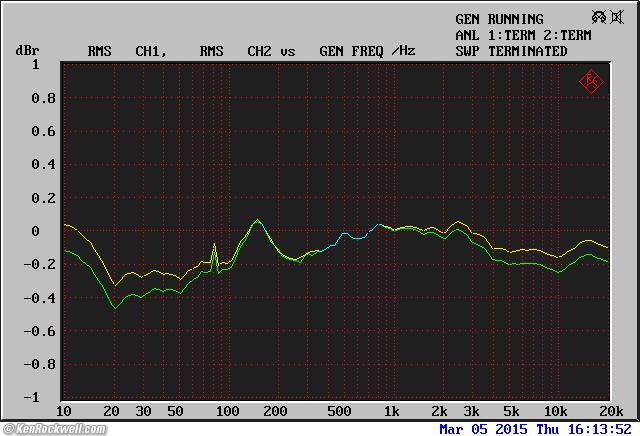Home Donate New Search Gallery Reviews How-To Books Links Workshops About Contact
Crown IC 150
Stereophonic Preamplifier (1971-1977)
© 2015 KenRockwell.com. All rights reserved.
Intro Specifications Measurements Usage Recommendations More
Crown IC 150 (about $250 used) in optional 10" deep walnut veneer case. enlarge. I got these at this link directly to them at eBay (see How to Win at eBay).
This free website's biggest source of support is when you use those or any of these links to approved sources when you get anything, regardless of the country in which you live — but I receive nothing for my efforts if you take the chance of buying elsewhere. I get no government hand-outs and run no pledge drives to support my research, so please always use any of these links to approved sources for the best prices, service and selection whenever you get anything. Thanks for helping me help you! Ken.
Rear, Crown IC 150, no wood case. enlarge.
April 2015 Crown reviews audio reviews all reviews
Introduction top
Intro Specifications Measurements Usage Recommendations More
The Crown IC 150 was a state-of-the-art preamplifier when it came out in 1971. It offered an unheard of level transparency due to its ultra-low noise levels.
This is a top-quality American-made preamplifier, listing for the equivalent of over $1,500 when new.
The Crown IC 150A is a newer version not covered here; this review is of the original Crown IC 150 Integrated Circuit Stereo Console.
Crown calls this an Integrated Circuit Stereo Console because in its day, integrated circuits were the height of technology. Preamplifiers were often called consoles, as just like a broadcast console, because they are the control center for your entire home entertainment system.
Before you write this off as a goof, as anyone who can read a schematic will see (and contrary to the flowery press at the time), the IC 150 is an almost entirely passive preamp!
The IC 150 has an entirely passive input selector and tape monitor and recording system. The volume control and loudness compensation circuits are entirely passive. The Balance and Panorama controls are completely passive. Even the HIGH and LOW filters are completely passive. To get 12 dB/octave for the passive HIGH filter, the IC 150 uses one inductor in each channel to make a classic LC filter.
The advantage of passive circuits is that they add no distortion and no noise, and have unlimited dynamic range and output level.
The only active circuitry in the entire line-level audio path is a single LM301AN operational amplifier in each channel, which provides 20 dB of gain. The tone controls work in the feedback loop of this one op-amp. This simplicity is how Crown got this to work and sound so well.
How simple is it? Even with the phono preamp and all the relays and other control logic and power light, the entire preamp draws only an actual measured 2.7 watts from the wall — less power when ON than most modern HiFi gear wastes while it's off!
Each single op-amp is an 8-pin DIP with a socket. It didn't seem to make any difference when I swapped the two stock LM301ANs for NE5534APs. Do not try this unless you have an engineering degree and an FCC broadcast engineering license, otherwise all you'll do is destroy some classic equipment. I didn't look for oscillation, as may happen when a hotter, wider-band IC is substituted, which would also destroy your tweeters. Beware; keep your hands out of this thing unless you have a licence.
The tone controls have separate left and right adjustments, popular back in the day. With mono records still in most people's collections, we boosted the bass and cut the treble on the right, and boosted the treble and cut the bass on the left, to simulate stereo. This put the violins on the left and the basses on the right.
The separate phono preamp board, mounted right at the phono input connectors, has several discrete transistors. It's also a gem, using 1% resistors and 2.5% capacitors for precise adherence to the RIAA curve. It also has rear-panel adjustable gain for each channel from 30 ~ 50 dB so your turntable's level and balance can match your other components.
It runs from regulated ± 18V supplies giving this Crown an output of 11.7 V RMS of hot, clean audio, not the wimpier ± 15 V supplies more popular today that limit their output levels to about 8 V RMS.
This preamplifier is made to commercial standards, with G-10 glass epoxy circuit boards and a mu-metal shielded power transformer.
Specifications top
Intro Specifications Measurements Usage Recommendations More
See Crown's superbly written manuals part 1, part 2 and part 3.
Input Impedance
100 kΩ.
Output Source Impedance
600 Ω.
Crown says the tape outputs are also 600Ω, but since they are just hard-wired from the inputs, they will be the same as the inputs.
Output Slew Rate
4.25 V/µS.
Size
3 RU (rack units) tall = 5.25".
5-1/4 x 17 x 8-1/8 HWD.
Weight
10 pounds.
Add 6 pounds for the beautiful walnut veneer case, 10" deep.
Quality
Hand-made in Elkhart, Indiana, USA.
Power
Power cord is flexible 2/16 heater cord.
Power switch rated 25 Amperes.
Switched outlets rated 1,200 watts.
2.7 watts, measured power consumption. 2 W rated.
1/8 A fuse (1/16 when set to 240 VAC).
0 watts when off.
Power light is red neon.
1971: $1,550 list price, corrected for inflation in 2015 ($269 list price at the time). Cabinet: $199 including inflation ($33 at the time).
1975: $1,525 list price, corrected for inflation in 2015 ($349 list price at the time).
March 2015: about $250 used, if you know How to Win at eBay.
Measurements top
Intro Specifications Measurements Usage Recommendations More
Gain Volume Control Channel Balance
Tone Controls Loudness Filters
These are 2015 measurements of my sample made in 1977.
These measurements were made with an exotic Rohde & Schwarz UPL laboratory analyzer. The traces from the Rohde & Schwarz UPL laboratory analyzer are color coded for the Left Channel and for the Right Channel. When they don't lie on top of each other, it's due to channel imbalance. When they do lie on top of each other, the trace turns blue.
Unless otherwise specified, all measurements are RMS at unity gain (about 2 o'clock) at 1 volt RMS loaded by 200 kΩ with a 120 VAC supply.
Gain measurements top
20.943 dB left, 20.900 dB right.
0 dB comes at about 2 o'clock, and -20 dB comes at about 10 o'clock.
Volume Control measurements top
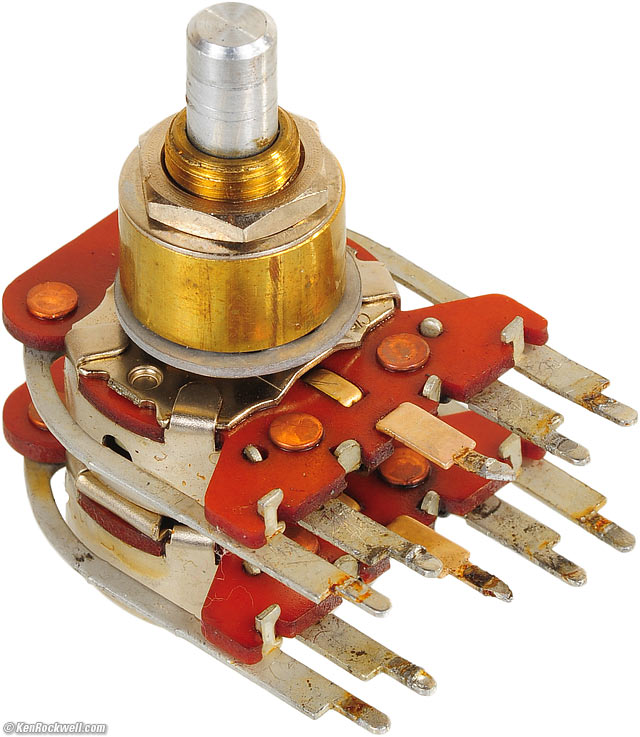
Crown IC 150 500 kΩ Volume Control Potentiometer.
The volume control is a custom CTS 500 kΩ pot with two loudness taps per channel. Therefor there are five terminals per channel, for a total of ten connections. It uses all these taps for its complex loudness circuit.
Mine had a defective side and there's no easy way to replace this complex part and retain the original loudness contours.
Considering that this control never tracked very well anyway, I replaced it with a 23-step 500k Ω control and connected to the appropriate steps, bottom tap at 43k Ω from ground and top tap at 104k Ω from ground:
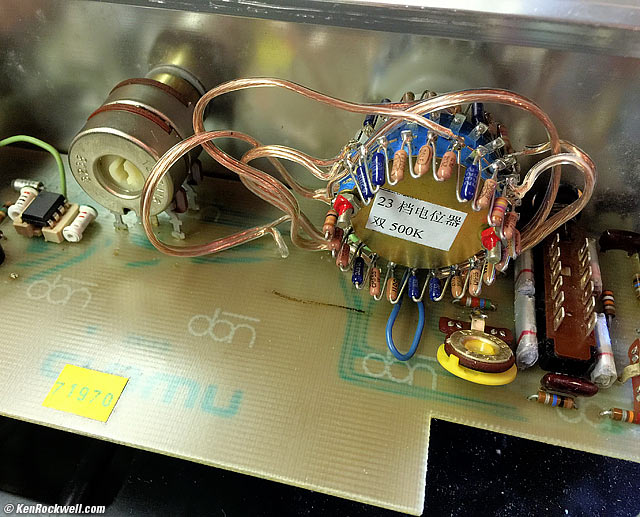
Chinese Step Pot installed.
It may be ugly, but Bingo!, I had a much improved IC 150 with a volume control that tracks perfectly.
I was too lazy to calculate and build my own control with the taper I preferred from a bare switch and my own resistors. As you'll see the channels track great and the loudness circuit works exactly as intended, but the steps aren't optimum with the completed control I purchased already assembled:
Step |
Left |
Right |
Position |
MAX |
+20.906 dB |
+20.899dB |
5 o'clock |
1 |
+10.627 dB |
+10.699 dB |
|
2 |
+7.417 dB |
+7.482 dB |
4 o'clock |
3 |
+4.202 dB |
+4.256 dB |
|
4 |
+0.510 dB |
+0.5425 dB |
3 o'clock |
5 |
-5.070 dB |
-5.080 dB |
top loudness tap |
6 |
-8.824 dB |
-8.837 dB |
(-11.73 dB in-between) |
7 |
-13.699 dB |
-13.714 dB |
(-19.875 dB in-between) |
8 |
-21.237 dB |
-21.243 dB |
bottom loudness tap |
9 |
-24.143 dB |
-24.145 dB |
|
10 |
-27.223 dB |
-27.221 dB |
12 o'clock |
11 |
-29.522 dB |
-29.522 dB |
|
12 |
-31.67 dB |
-31.67 dB |
11 o'clock |
13 |
-33.62 dB |
-33.62 dB |
|
14 |
-35.65 dB |
-35.66 dB |
10 o'clock |
15 |
-37.89 dB |
-37.91 dB |
|
16 |
-40.42 dB |
-40.44 dB |
9 o'clock |
17 |
-43.18 dB |
-43.18 dB |
|
18 |
-46.40 dB |
-46.40 dB |
8 o'clock |
19 |
-50.41 dB |
-50.41 dB |
|
20 |
-57.23 dB |
-57.24 dB |
7 o'clock |
MIN |
-70.61 dB |
-70.62 dB |
|
Zero |
-122 dB |
-122 dB |
6 o'clock |
#5: top loudness tap, 99.4k Ω from bottom, green trimmer.
#8: bottom loudness tap, 41.4k Ω from bottom, yellow trimmer.
Channel Balance measurements top
The volume control is a custom multi-tap potentiometer, with two trim adjustments on the circuit board for tracking!
This said, my sad old sample didn't track all that well; I have no idea how good it was when new.
Crown specified it to within ± 2 dB or ±3 dB (depending on where you read it) over a 60 dB range.
Mine tracks well over the top 40 dB (+20 to -20 dB gain), but mine is poor below that.
I replaced it with a 23-step 500 kΩ volume control, and now it tracks to within ±0.03 dB.
Maximum Output measurements top
11.7 volts (21.36 dBV) at 0.1% THD, measured.
11.94 volts (21.54 dBV) at 0.1% THD, measured after calibrating power supplies to ±18.00 VDC (were 17.5VDC).
11.7 volts (21.36 dBV) at 0.1% THD, measured after swapping to NE5534AP, whose higher power consumption lowered power supply rails to ±17.94 VDC.
Output Noise measurements top
LM301AN |
A Weighted |
Unweighted 22k |
MAX |
-90 dBV A |
-87 dBV |
0 dB (2 o'clock) |
-87 dBV A |
-84 dBV |
Min |
-90 dBV A |
-87.1 dBV |
with NE5534AP |
A Weighted |
Unweighted 22k |
MAX |
-94.3 dBV A |
-90.8 dBV |
0 dB (2 o'clock) |
-88 dBV A |
-85 dBV |
Min |
-94.4 dBV A |
-91 dBV |
Signal to Noise Ratio (SNR) measurements top
108.36 dB A-weighted SNR (17.4 effective bits) referred to maximum output.
Output DC Offset measurements top
Less than 40 microvolts; it's capacitor coupled.
Frequency Response ±0.2 dB 10~55,000 Hz measurements top
IC 150 Frequency Response.
40 years old and flatter than many preamps today! It's +0.2, -0.0 dB from 10 cycles to 20 kc.
IC 150 Infrasonic Frequency Response.
An odd +0.6 dB peak at 1.8 cycles, and then -3 dB at 0.5 Hz, falling at 12 dB/octave below that.
IC 150 Ultrasonic Frequency Response.
Tone Controls measurements top
The tone controls have a huge range and sound good. They have nearly a ±20 dB range!
IC 150 frequency response, tone controls centered, expanded scale.
Response is flat, with the controls centered but active. This is a very expanded scale.
IC 150 BASS control frequency response at 7, 9, 10 11, 12, 1, 2, 3, and 5 o'clock.
This is a real bass control: it boosts or cuts mostly below 100 Hz where it matters and doesn't muck-up the lower midrange as do poorer bass controls.
The channels didn't balance well with the bass control at 2 o'clock. The response was about the same at the 3 and 5 o'clock settings.
IC 150 TREBLE control frequency response at 7, 9, 10 11, 12, 1, 2, 3, and 5 o'clock.
The treble response was about the same at the 3 and 5 o'clock settings.
Loudness Compensation measurements top
The IC 150 also has solid loudness compensation, with 20 dB of bass boost!
This loudness boost is in addition to any settings of the tone controls. With 20 dB of Loudness boost and 20 more dB of Bass control, this is a real man's preamp.
At +20 dB of gain (maximum volume), response is flat.
IC 150 Loudness compensation, +10 dB gain.
IC 150 Loudness compensation, 0 dB gain (Volume 2 o'clock).
IC 150 Loudness compensation, -9 dB gain.
IC 150 Loudness compensation, -21 dB gain (Volume 10 o'clock).
IC 150 Loudness compensation, -40 dB gain.
Whoo eee! I love old loudness contours. These used to rattle the 15" paper accordion suspension woofers so popular back in the day. Note how this is a real man's loudness contour, still boosting more and more even as we approach 10 cycles per second, and still rising!
There's a catch: the high frequencies are boosted, especially the ultrasonics. While not a problem in 1977 when this sample was built, it could be a big tweeter-frying problem today if you listed to SACDs or use a DAC without a proper low-pass filter that passes ultrasonic hash.
IC 150 ultrasonic loudness compensation, +10 dB gain.
IC 150 ultrasonic loudness compensation, 0 dB gain.
IC 150 ultrasonic loudness compensation, -9 dB gain.
IC 150 ultrasonic loudness compensation, -20 dB gain.
IC 150 ultrasonic loudness compensation, -40 dB gain.
Did you catch that? At some settings, like -9 dB, there is loss midband, while at 110 kc you have 21-9 = 12 dB of gain!
Here's the ultrasonic loudness with the HIGH filter:
IC 150 ultrasonic loudness compensation, -40 dB gain.
If you use both Loudness as well as the HIGH filter at the same time, it turns it into a 9 kc, 6 dB/octave high filter .
Filters measurements top
IC 150 HIGH filter.
The HIGH filter is strong: 12 dB/octave at 5 kHz. This was the sad reality of the LPs people had to deal with back then; we needed this strong filter to help cut out the noise, scratches, record wear and its resulting distortion.
IC 150 LOW filter.
The LOW filter is a joke, 6 dB/octave at 50 Hz rated, 17 Hz actual. I don't even know why they bothered.
THD measurements top
IC 150 THD versus output level.
IC 150 THD at 100 mV output level.
IC 150 THD at 2 V output level.
IC 150 THD at 10 V output level.
Phono Section measurements top
This is measured from the Phono input to the Tape Output.
Phono Preamp Gain
The gain is adjustable on the back panel:
Gain, Left |
Gain, Right |
|
MAX |
50.43 dB |
50.39 dB |
As received |
41.68 dB |
41.60 dB |
Set to for review |
40.00 dB |
40.00 dB |
Min |
30.35 dB |
29.26 dB |
I set the gain precisely to 40.00 dB in both channels for the next measurements.
Phono Preamp Tape Output Noise
At 40.00 dB gain: -90 dBV A-weighted, -83 dBV unweighted in 22kHz bandwidth.
Phono Preamp Frequency Response
IC 150 THD phono section RIAA response.
This shows outstandingly flat response. To be honest, these little bumps are showing the random errors in my R&S RIAA.VEQ generator equalizer file more than the preamp's variation.
NE5534AP measurements top
With socketed 8-pin single op-amps, it's easy to pop in different op-amps if you're an engineer. I tried using two NE5534AP, and it works fine, with about 4 dB less noise and much less distortion at high output levels, especially at high frequencies.
The low-frequency response, tone controls and loudness and filters all work the same.
There's about 1 dB less response at 110 kc.
Here's its distortion with two NE5534AP:
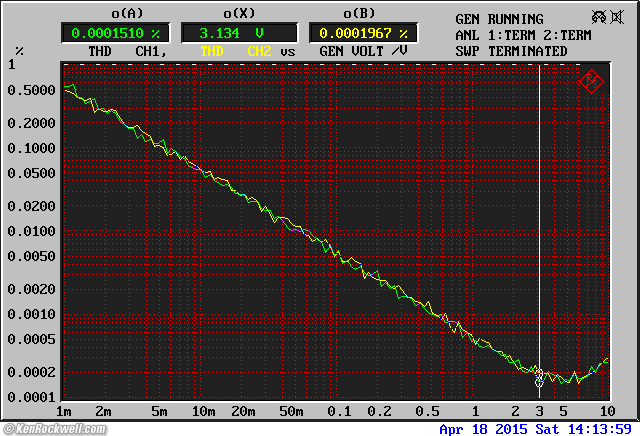
Crown IC 150 distortion versus level with NE5534AP.

Crown IC 150 distortion at 10 V RMS with NE5534AP.
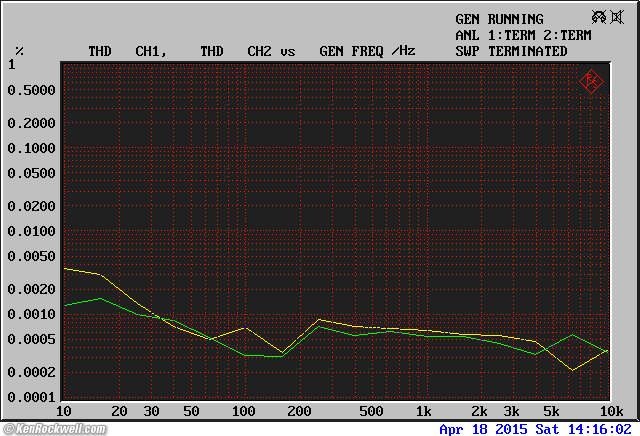
Crown IC 150 distortion at 1 V RMS with NE5534AP.
Measured Power Consumption measurements top
2.7 watts.
2.95 watts with NE5534AP.
Usage top
Intro Specifications Measurements Usage Recommendations More
Crown's superbly written manuals part 1, part 2 and part 3 are worth the read even if you don't get one of these. They are the ultimate examples of how to write a manual well, and capture the period magnificently. For instance, it says the pictures illustrating the Panorama Control suggest Peter Nero's piano and Robert Goulet singing. It says set to mono and the singer sits on the piano al la Dean Martin.
Don't waste your time with power strips; plug your entire system into the outlets on the back of the IC 150 and now the IC150's power switch controls your entire system.
The IC 150 shorts unused inputs to ground. Be careful! My test generator kept shutting itself off and warning GENERATOR OVERLOAD because of this. Crown does this to ensure that other inputs like your tuner don't leak into the sound when you're listening to another input.
There is an output mute relay that shorts the output to ground when off, and for several seconds for turn-on. Mine has a 3.7s delay, and Crown specifies anywhere from 3 to 7 seconds depending on where you read it. This reed relay is just about silent; you will probably never hear it click on or off.
There are terminals on the back for for an external remote mute control. These have to be wired together or you will get no sound! Crown says use this and put the switch by your phone, for instance, to eliminate the risk of falls running back to your HiFi console on your way to answer the phone.
Don't select a recorder while it's set in its source mode or you might get oscillation.
Crown included cheater plugs with this preamp, and told you to cut off the green wires and forget about grounding your other equipment via anything other than the signal leads, electrical codes be darned. Crown warns if you use grounded power plugs that you run the risks of ground loops and oscillation.
The unique Panorama control, according to Crown, "replaces confusing stereo mono switches." It "helps reduce ping pong stereo, especially with headphones," referring to the hard-panned stereo common in its day.
When set to Mono, the balance control selects the mix between the source channels; both outputs are forced to be equal to each other in Mono regardless of the Balance or Tone controls.
Recommendations top
Intro Specifications Measurements Usage Recommendations More
The IC 150 is a bit clunky today, but it's a perfect classic for listening to period music like Frank Sinatra, David Oistrakh, Beatles or your high-resolution copies of The Who.
This American classic looks stunning, displaying unquestioned authority over the all-black imported rubbish for which too many people settle today as excuses for home entertainment. Pair this with a DC-300 and you're in HiFi heaven — or crank it up and you can send the whole neighborhood straight to elsewhere.
As a period piece, be sure to mount it either in it's optional dedicated walnut case as shown at the top, or as part of a larger Hi-Fi system inside a larger custom piece of furniture. Crown's cases come in many different depths and heights and with or without top vents; this preamp fits a 10" deep or deeper cabinet.
If you just want to use the very quiet and accurate phono preamp alone, you can do just that by connecting the tape output to your "real" preamp. This bypasses all the rest of the IC 150's circuitry.
Only if you're an engineer, this preamp has so much headroom with its 11.7 V MOL that you can pad-down the output by 10 dB and still have 3.7 V output, more than enough to fry any power amp, and drop the noise by 10 dB in the process. Of course the Loudness compensation will be less, since you'll have the Volume control turned up an extra 10 dB for the same levels as before.
Crown has the manuals online (part 1, part 2 and part 3) and most of the parts are pretty standard, so repairs should be easy for qualified service personnel. For instance, my "untested" dumpster find had a dead channel, but all it needed was a 50¢ plug-in LM301AN and it was fixed. Good ones should last forever, they are made to professional standards.
The one I purchased had a 32 Amp fuse in it; you might want to check that your fuse really is a relatively uncommon 1/8 A fuse. A 32 A fuse won't protect anything.
All kidding aside, this preamp's merits are that its ample Loudness compensation and excellent tone control curves let us correct our programming to get the best sound from our system. I really like the way the Bass control boosts, which is important for much programming, especially when enjoyed at quieter levels. The Bass control lets us optimize the lower bass without mucking-up the upper bass as too many tone controls do today. These tone and Loudness controls are why so many people love the sound of old tube gear. It's not the tubes; it's the more euphonic equalization that the older gear used to get better sound out of the big but not particularly tough speakers of the day.
More Information top
Intro Specifications Measurements Usage Recommendations More
Crown's manuals part 1, part 2 and part 3.
Review in Audio magazine, January 1972.
Help me help you top
I support my growing family through this website, as crazy as it might seem.
The biggest help is when you use any of these links when you get anything, regardless of the country in which you live. It costs you nothing, and is this site's, and thus my family's, biggest source of support. These places have the best prices and service, which is why I've used them since before this website existed. I recommend them all personally.
If you find this page as helpful as a book you might have had to buy or a workshop you may have had to take, feel free to help me continue helping everyone.
If you've gotten your gear through one of my links or helped otherwise, you're family. It's great people like you who allow me to keep adding to this site full-time. Thanks!
If you haven't helped yet, please do, and consider helping me with a gift of $5.00.
As this page is copyrighted and formally registered, it is unlawful to make copies, especially in the form of printouts for personal use. If you wish to make a printout for personal use, you are granted one-time permission only if you PayPal me $5.00 per printout or part thereof. Thank you!
Thanks for reading!
Mr. & Mrs. Ken Rockwell, Ryan and Katie.
Home Donate New Search Gallery Reviews How-To Books Links Workshops About Contact

